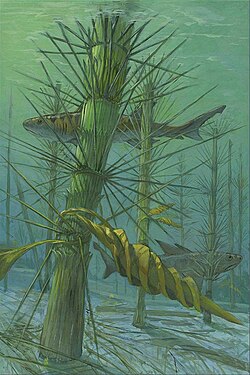Earth:Palaeoxyris
| Palaeoxyris | |
|---|---|

| |
| Diagram of a Mesozoic type Palaeoxyris specimen | |
| Trace fossil classification|Trace fossil classification Error creating thumbnail: Unable to save thumbnail to destination
| |
| Domain: | Eukaryota |
| Kingdom: | Animalia |
| Phylum: | Chordata |
| Class: | Chondrichthyes |
| Subclass: | Elasmobranchii |
| Order: | †Hybodontiformes |
| Ichnogenus: | †Palaeoxyris Brongniart, 1828 |

Palaeoxyris is a morphogenus of eggs cases, widely thought to have been produced by hybodonts, with a predominant occurrence in ancient freshwater environments. They comprise a beak, a body and a pedicle. They display a conspicuous right-handed spiral of collarettes around the body, and in some cases, the pedicle, resulting in a rhomboidal pattern when flattened during fossilisation.[1] At the end of the beak was a tendril which attached the egg to vegetation during development.[2] The body of the egg ranges in length from 1.2–8.9 centimetres (0.47–3.50 in), depending on the species.[3]
Originally described as plant remains (being named after the plant genus Xyris), it took decades before their true nature as animal eggs was revealed.[4] Nearly 30 different Palaeoxyris species are currently known with a stratigraphic range from the Carboniferous to the Cretaceous.[1][5] Mesozoic Palaeoxyris specimens differ from Paleozoic specimens by having the twisting of the collarette end at the beginning of the pedicle, rather than the spiraling continuing down the pedicle as in Paleozoic specimens.[6] Likely hybodont producers of some of the eggs assigned to the genus include the genus Lonchidion.[5]
References
- ↑ 1.0 1.1 Ronald Böttcher (2010). "Description of the shark egg capsule Palaeoxyris friessi n. sp. from the Ladinian (Middle Triassic) of SW Germany and discussion of all known egg capsules from the Triassic of the Germanic Basin". Palaeodiversity 3: 123–139. http://www.palaeodiversity.org/pdf/03/Palaeodiversity_Bd3_Boettcher.pdf.
- ↑ Krüger, Ashley; Slater, Sam; Vajda, Vivi (2021-07-03). "3D imaging of shark egg cases ( Palaeoxyris ) from Sweden with new insights into Early Jurassic shark ecology" (in en). GFF 143 (2-3): 229–247. doi:10.1080/11035897.2021.1907442. ISSN 1103-5897. https://www.tandfonline.com/doi/full/10.1080/11035897.2021.1907442.
- ↑ Fischer, Jan; Axsmith, Brian J.; Ash, Sidney R. (2010-03-01). "First unequivocal record of the hybodont shark egg capsule Palaeoxyris in the Mesozoic of North America". Neues Jahrbuch für Geologie und Paläontologie - Abhandlungen 255 (3): 327–344. doi:10.1127/0077-7749/2009/0028. ISSN 0077-7749. http://dx.doi.org/10.1127/0077-7749/2009/0028.
- ↑ Jan Fischer; Ilja Kogan (2008). "Elasmobranch egg capsules Palaeoxyris, Fayolia and Vetacapsula as subject of palaeontological research – an annotated bibliography". Freiberger Forschungshefte C 528: 75–91.
- ↑ 5.0 5.1 Jan Fischer; Sebastian Voigt; Jörg W. Schneider; Michael Buchwitz; Silke Voigt (2011). "A selachian freshwater fauna from the Triassic of Kyrgyzstan and its implication for Mesozoic shark nurseries". Journal of Vertebrate Paleontology 31 (5): 937–953. doi:10.1080/02724634.2011.601729.
- ↑ Fischer, Jan; Licht, Martin; Kriwet, Jürgen; Schneider, Jörg W.; Buchwitz, Michael; Bartsch, Peter (2014-04-03). "Egg capsule morphology provides new information about the interrelationships of chondrichthyan fishes" (in en). Journal of Systematic Palaeontology 12 (3): 389–399. doi:10.1080/14772019.2012.762061. ISSN 1477-2019. http://www.tandfonline.com/doi/abs/10.1080/14772019.2012.762061.
Wikidata ☰ Q7126520 entry
 |

